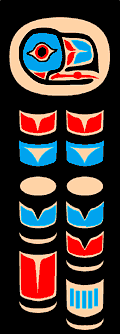 |
 |
 |
|
|
Martha has always loved Native Art - the Woodlands style of the Ojibwa, the pottery of the Southwest, the carvings of the Inuit, but most of all she was drawn to the bold graphic designs of the Northwest Coast. There were totem poles, wonderful wooden masks, bentwood boxes, and carved ceremonial objects. Most surfaces were painted with the red and black stylized figures of creatures, both real and supernatural. Each winter long ago, the Northwest Coast Peoples would hold elaborate ceremonies. It was the time to re-enact old myths and legends, using wonderful masks and costumes, along with elaborate scenery and the occasional puppet. Many of these ceremonial items were passed down from generation to generation, and some have found their way into museums around the world.
Martha was inspired by these artifacts, to create a series of figures representing some of the legends of the Northwest Coast. She has gone to great lengths to replicate the elaborate designs as authentically as possible, and has combined the various styles of the many individual cultures to create a unique figure of her own design.
|
|
 |
|
|
|
|
|
|
|
|
|
|
|
|
|
select any thumbnail to see another view
|
|
|
|
Raven Steals The Sun
The Storyteller, proportioned as a traditional “Welcome Figure”, is a collage of the various authentic West Coast styles. He is an interpretation of a West Coast Shaman presenting the legend “Raven Steals The Sun”. Each part of his regalia represents part of the story.
The Raven puppet is the main character in the story, which takes place long, long ago, before there was light in the world.
The front pendant on the figure, and the leather dance apron both depict the Old Chief who owns the bentwood cedar box in which the sun, moon, and stars are kept.
The sides of the box depict Raven and the Chief’s Daughter, who goes to fetch water. Raven transforms himself into a spruce needle, which falls into the water. The daughter swallows it, becomes pregnant, and soon gives birth to an obnoxious baby boy, who grows at a phenomenal rate. The boy (Raven) screams all day long to play with the contents of the box.
Finally, the Chief relents “Just this once”. As soon as the box is opened, Raven transforms back to his natural form, grabs the Sun with his beak, and flies up through the smoke hole, high into the sky, placing the Sun there to shed light on the whole world.
Height: 43 cm
Media: Cloth doll with wire armature. Hair of black mohair, embroidered beard, painted eyes. Leather dance apron with shells. Wooden leggings. Button blanket of red & black fabric, with handmade polymer clay buttons. Puppet of cardboard and paperclay. Hat of cardboard and paperclay. Masks of paperclay. Raffia, yarn, feathers.
Awards: Won the Rosette for Best Doll in the Mythology Challenge, at the Canadian Doll Artists Association Conference, May 2004.
Raven Steals the Sun is featured in the Spring 2005 issue of Art Doll Quarterly
|
|
 |
|
|
|
|
|
|
|
|
|
|
|
|
|
select any thumbnail to see another view
|
|
|
|
Raven Steals Beaver Lake
This figure is an interpretation of a Northwest Coast Native style Storyteller. Each part of his regalia represents some part of the traditional story in which Raven, transformed as a man, deceives Beaver, steals his lake, and brings salmon to all the rivers and lakes along the west coast.
The puppet depicts Raven transforming from human form back into his true form, after he has stolen the fish. The dance apron and mask depict Beaver, as does the crosshatching design on the figure’s moccasins. The pendant around his neck depicts Beaver Lake with the salmon. The cedar hat is also painted with salmon designs, and has a large sculpted salmon. The traditional red and black button blanket has a large salmon embellished with hundreds of handmade polymer clay buttons.
Height: 44 cm
Media: Cloth doll on a wire armature. Black Mohair hair, embroidered beard, painted eyes. Leather dance apron and leggings with shell fringe. Button Blanket of red & black fabric with handmade polymer clay buttons. Puppet of wood and Paperclay. Hat of turned cedar. Paperclay salmon on hat, salmon lake pendent, and Beaver mask. Raffia, yarn. feathers.
|
|
 |
|
|
|
|
|
|
|
|
|
|
|
|
|
select any thumbnail to see another view
|
|
|
|
Thunderbird
Thunderbird is a marvelous creature of myth, living high in the mountains, the most powerful of all the spirits in Northwest Coast Native legend. This figure is an anthropomorphic representation of a combination of a native dancer in “thunderbird regalia” and an actual Thunderbird as depicted on northwest coast totem poles. The body is in human proportion, but he has Thunderbird head, feet, and wings. From the waist down, the figure is more bird-like, but the torso is more human-like. Wings are a combination of real feathers (Canada Goose) and symbolic painted cedar feathers. The mask on the tail joint is true to the Northwest Coast tradition of portraying a face on many of the main body joints of both carved and painted figures. The masks on the end of the arms, are the heads of the Lightning Snakes which live under the Thunderbird’s wings. The lightning Snake’s body is depicted on the top edge of each wing.
Height: 41 cm
Media: Head, feet, and masks of Paperclay. Cloth body with wire armature. Canada goose feathers, cedar feathers and lightning snake body. Raffia, driftwood, red & black fabrics with polymer clay buttons.
Awards: Won First place in the “Animal” category,a t the Canadian Doll Artists Association Conference, May 2006. Also won Best In Show with the highest score overall.
|

|
|
|

